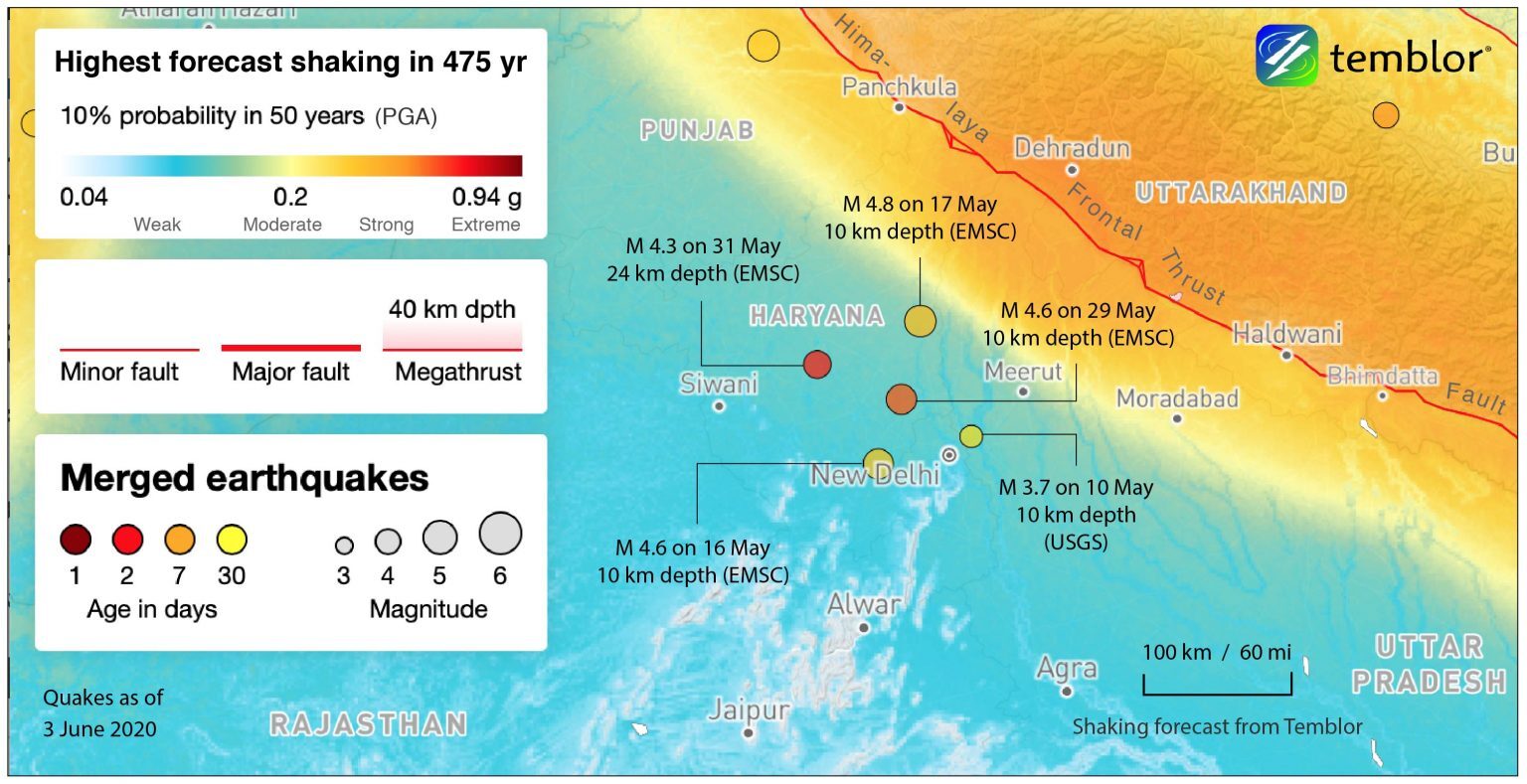
© temblor
On Monday afternoon, the capital city of India witnessed yet another low-intensity earthquake. The National Center for Seismology revealed the epicentre of the earthquake was near Gurgaon, Haryana, and its depth was recorded to be 19 km with a magnitude of 2.1. Mild tremors were reportedly felt in Delhi, Noida, and the surrounding areas for a few seconds.
Just a week ago, on June 3, Delhi NCR had witnessed another earthquake of magnitude 3.2 on the Richter scale, which struck 19 km southeast of Noida. Further back, on May 29, an earthquake measuring 4.6 on the Richter scale jolted the NCR.
Since April 2020, New Delhi and nearby areas have recorded more than 14 earthquakes. According to the National Center for Seismology, all these earthquakes fell into the range of low to medium, as their magnitude was less than five.
This phenomenon, involving a collection of related earthquakes focused on a particular area for a limited period, is called 'swarm' activity. The swarm activity may or may not have an apparent triggering event behind it: say a large earthquake or a huge landslide.
Why the frequent Earthquakes in and around Delhi?The primary cause for an earthquake is the movement of rocks beneath the earth's surface. The movement is usually caused by the continuous movement of plates that make up Earth's crust. This movement exerts stress on rocks, causing the latter to respond by breaking along existing fractures called fault lines. The sudden release of energy during such breakup causes the tremors.
According to experts, Delhi's geographical location makes it prone to frequent earthquakes, as it lies in the Himalayan foothills.
Scientific studies have highlighted that the Indian plates are continuously driving towards the Eurasian plates at a rate of 5-6 cm per year. About 55 million years ago, when the Indian plates crashed into the Eurasian plate, the force of the collision was so strong that it led to the upward folding of the crust. As a result of this collision, the Himalayan ranges were formed.
Experts have stated that since the formation of the Himalayas, a large part of the crust under the mountain ranges has remained deformed. These rocks remain stressed and folded due to the continuous movement of the Indian plates under the mountain. And when the piled-up stress gets released, it produces minor frequency earthquakes in and around the National Capital Region.
Stronger earthquake on the cards"A series of such earthquakes ostensibly warn of a major earthquake to hit Delhi in coming days. One of the reasons for increasing numbers of tremors hitting Delhi is that the local fault system here is quite active. Such fault systems around Delhi are capable of producing an earthquake of magnitude around 6 to 6.5," says Dr A K Shukla, former Head of Earthquake Risk Evaluation Centre, Indian Meteorology Department.
Dr Kalachand Sain, Chief of Wadia Institute of Himalayan Geology, says that while we cannot predict the time, place, or the exact scale of these quakes, consistent seismic activity around the Delhi-NCR region could be a precursor to a major earthquake.
There are a total of four seismic zones in India. According to the Bureau of India Standards, Delhi-NCR falls under seismic zone four, which states that parts of the region are prone to high damage.
The long-term seismological analysis in the Himalayan region shows that the amount of energy getting accumulated in the subduction zones is not equally dissipated through the small and moderate earthquakes that are happening right now. The energy has been building up, and the only relief is a strong earthquake.
Delhi and its border towns are witnessing consistent growth of the high rise private buildings, plenty of which do not adhere to mandatory guidelines of Bureau of Indian Standards (BIS) set for earthquake-resistant construction
"Everyone knows that Delhi-NCR falls under seismic zone-4, and it's prone to tremors but still most of the builders do not conform to the norms of BIS. There is a nexus between architects and builders which somehow compromise the stringent earthquake (resistant) codes. So, on any given day, if an earthquake of higher magnitude strikes here, the consequences would be grievous," said Professor Chandan Ghose of IIT-Jammu.
In addition to Delhi, Jammu & Kashmir, Himachal Pradesh, Sikkim, Northern parts of Uttar Pradesh, Bihar, West Bengal, parts of Gujarat and Maharashtra (west coast), and Rajasthan all fall into seismic zone 4.
Many parts of north, east and northeastern India are at constant risk of strong earthquakes and these maximum risk areas for high-intensity earthquakes are classified as Zone-V in India. The zone broadly comprises entire northeastern India, parts of Jammu and Kashmir, Himachal Pradesh, Uttarakhand, Rann of Kutch in Gujarat, parts of North Bihar and Andaman & Nicobar Islands.
(With inputs from IANS)
Reader Comments
to our Newsletter